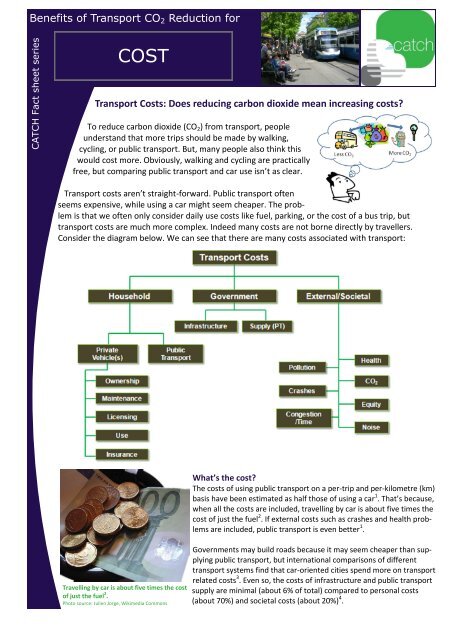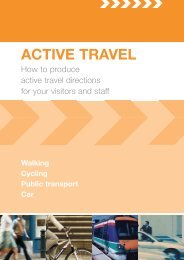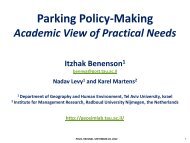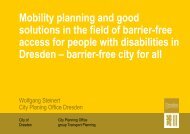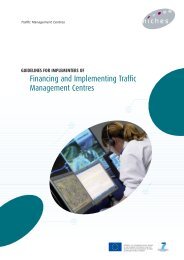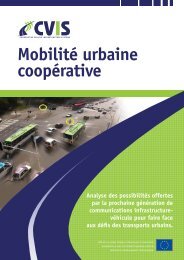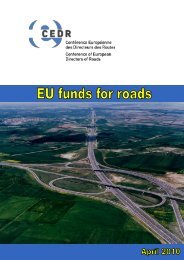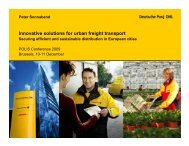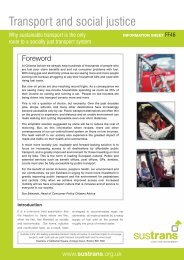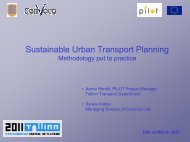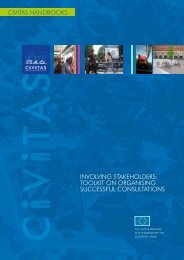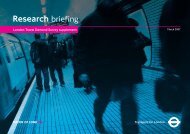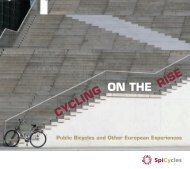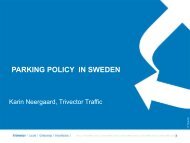Benefits of Transport CO2 Reduction for Transport Costs ... - Eltis
Benefits of Transport CO2 Reduction for Transport Costs ... - Eltis
Benefits of Transport CO2 Reduction for Transport Costs ... - Eltis
Create successful ePaper yourself
Turn your PDF publications into a flip-book with our unique Google optimized e-Paper software.
CATCH Fact sheet series<br />
<strong>Benefits</strong> <strong>of</strong> <strong>Transport</strong> CO 2 <strong>Reduction</strong> <strong>for</strong><br />
COST<br />
<strong>Transport</strong> <strong>Costs</strong>: Does reducing carbon dioxide mean increasing costs?<br />
To reduce carbon dioxide (CO 2 ) from transport, people<br />
understand that more trips should be made by walking,<br />
cycling, or public transport. But, many people also think this<br />
would cost more. Obviously, walking and cycling are practically<br />
free, but comparing public transport and car use isn’t as clear.<br />
<strong>Transport</strong> costs aren’t straight-<strong>for</strong>ward. Public transport <strong>of</strong>ten<br />
seems expensive, while using a car might seem cheaper. The problem<br />
is that we <strong>of</strong>ten only consider daily use costs like fuel, parking, or the cost <strong>of</strong> a bus trip, but<br />
transport costs are much more complex. Indeed many costs are not borne directly by travellers.<br />
Consider the diagram below. We can see that there are many costs associated with transport:<br />
What’s the cost?<br />
The costs <strong>of</strong> using public transport on a per-trip and per-kilometre (km)<br />
basis have been estimated as half those <strong>of</strong> using a car 1 . That’s because,<br />
when all the costs are included, travelling by car is about five times the<br />
cost <strong>of</strong> just the fuel 2 . If external costs such as crashes and health problems<br />
are included, public transport is even better 1 .<br />
Travelling by car is about five times the cost<br />
<strong>of</strong> just the fuel 2 .<br />
Photo source: Julien Jorge, Wikimedia Commons<br />
Governments may build roads because it may seem cheaper than supplying<br />
public transport, but international comparisons <strong>of</strong> different<br />
transport systems find that car-oriented cities spend more on transport<br />
related costs 3 . Even so, the costs <strong>of</strong> infrastructure and public transport<br />
supply are minimal (about 6% <strong>of</strong> total) compared to personal costs<br />
(about 70%) and societal costs (about 20%) 4 .
Congestion costs are another consideration. The cost <strong>of</strong> congestion<br />
is related to the value <strong>of</strong> what is being moved, with freight or<br />
work travel being valued greater than personal travel. There<strong>for</strong>e,<br />
one solution to reducing the costs <strong>of</strong> congestion could better be<br />
solved by shifting personal car trips to other modes 5 . Furthermore,<br />
the costs to society due to crashes are far greater than that<br />
<strong>of</strong> congestion 6 , suggesting that it is good to have some congestion<br />
that reduces overall speeds. Reducing the need to travel 7 is an important<br />
part <strong>of</strong> addressing the problems <strong>of</strong> congestion and many<br />
<strong>of</strong> the other points in the transport costs diagram.<br />
Car orientated cities spend<br />
more on transport.<br />
=<br />
Car orientated cities consume<br />
more tax money.<br />
Car use is less efficient than bus or rail per passenger km 3 , and assuming the same energy inputs, the<br />
CO 2 emissions will thus be larger by car on a km by km basis. To compound this, the citizens <strong>of</strong> cities<br />
that are more car-oriented on average typically travel further than citizens <strong>of</strong> more balanced systems<br />
within nations and across international comparisons 3 .<br />
To answer the initial question, whether reducing CO 2 from transport will reduce costs overall; the car is<br />
both inefficient in terms <strong>of</strong> energy use and in the resulting land-use requirements.<br />
How can the CATCH project help?<br />
The CATCH project will better in<strong>for</strong>m decision makers so that conclusions<br />
about transport will help reduce both costs to individuals while reducing<br />
CO 2 at the same time. CATCH will accomplish this by bringing to their<br />
attention the wider impacts <strong>of</strong> transport decisions through in<strong>for</strong>mative<br />
sheets such as this, measures related to those shown in the diagram,<br />
highlighting best practices <strong>for</strong> practitioners, and by improving knowledge<br />
within the general population on transport and its impacts.<br />
www.carbonaware.eu<br />
References:<br />
1<br />
Kennedy, C A. A comparison <strong>of</strong> the sustainability <strong>of</strong> public and private transportation systems: Study <strong>of</strong> the Greater Toronto Area. <strong>Transport</strong>ation 29(4),<br />
459-493. 2002.<br />
2<br />
American Automobile Association. Your Driving <strong>Costs</strong>. American Automobile Association Report. 2010.<br />
3<br />
Kenworthy, J R and Laube, F B. Patterns <strong>of</strong> automobile dependence in cities: an international overview <strong>of</strong> key physical and economic dimensions with some<br />
implications <strong>for</strong> urban policy. <strong>Transport</strong>ation Research Part A: Policy and Practice 33(7-8), 691-723. 1999.<br />
4<br />
Delucchi et al. The Annualized Social Cost <strong>of</strong> Motor Vehicle Use in the United States. Based on 1990–1991 Data, Davis, CA: University <strong>of</strong> Cali<strong>for</strong>nia, Institute<br />
<strong>of</strong> <strong>Transport</strong>ation Studies. 1996.<br />
5<br />
Goodwin, P. The Economic <strong>Costs</strong> <strong>of</strong> Road Traffic Congestion. ESRC <strong>Transport</strong> Studies Unit: A Discussion Paper published by the Rail Freight Group, London.<br />
2004.<br />
6<br />
Cambridge Systematics, Meyer, M D. Crashes vs. Congestion - What's the Cost to Society? American Automobile Association. 2008.<br />
7<br />
Banister, D. Reducing the need to travel. Environment and Planning B: Planning and Design 24. 437-449. 1997.<br />
This document has been written by partners in the CATCH consortium. For more in<strong>for</strong>mation, please contact the project coordinator:<br />
Steve Cassidy, MRC McLean Hazel: steve.cassidy@mrcmh.com Tel: +44 (0) 131 226 1045<br />
CATCH is a project co-financed by the European Union under the 7th Framework Programme <strong>for</strong> Research<br />
The sole responsibility <strong>for</strong> the content <strong>of</strong> this document lies with the authors. It does not necessarily reflect the opinion <strong>of</strong> the European Communities.<br />
The European Commission is not responsible <strong>for</strong> any use that may be made <strong>of</strong> the in<strong>for</strong>mation contained therein.


